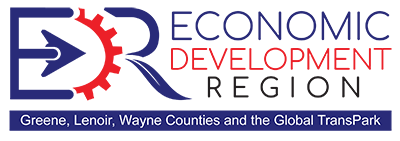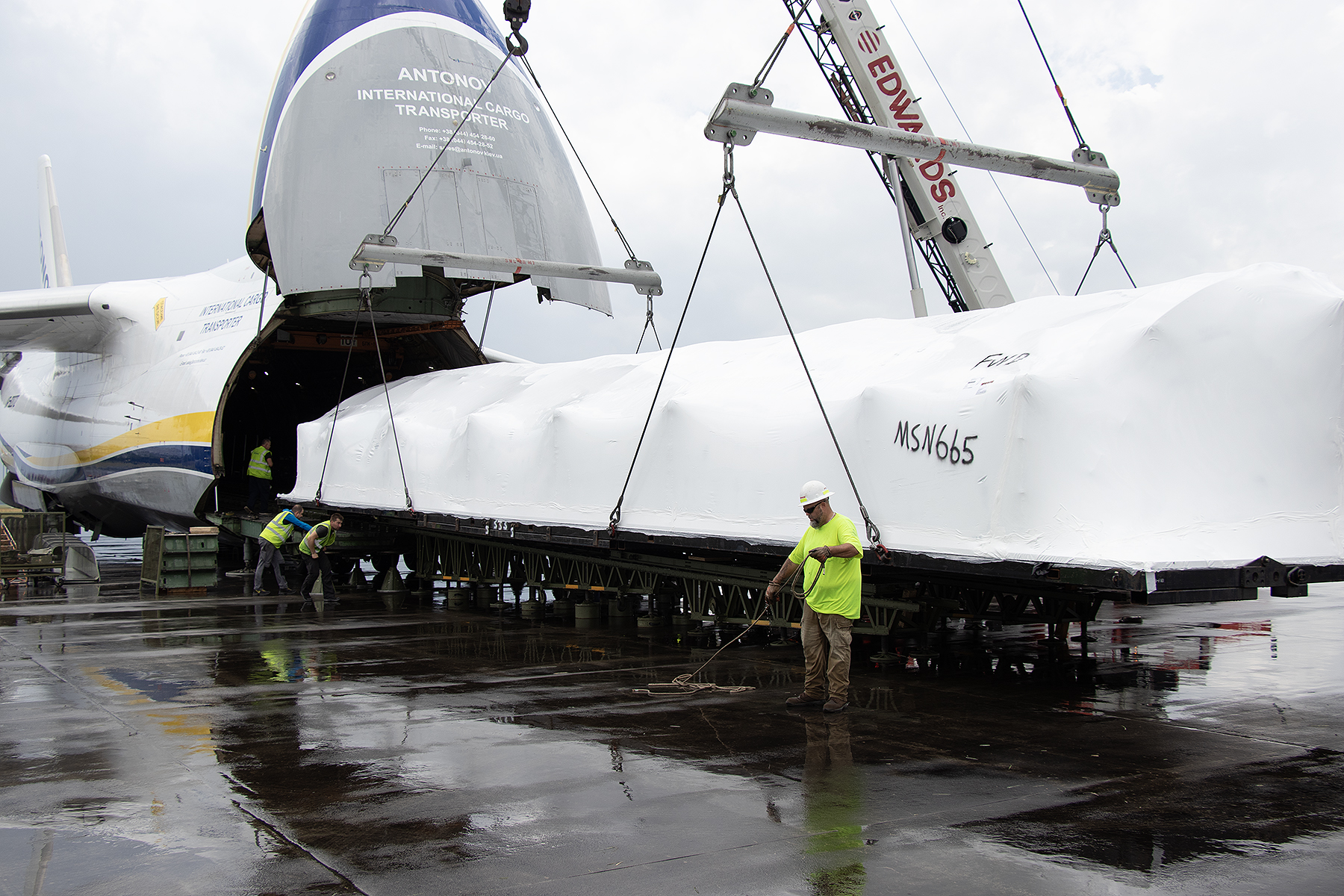NC Global TransPark and EDR’s Efforts Featured in Business North Carolina Article
Point taken: Global TransPark’s promise is looking brighter. By Dan Barkin
When I came to North Carolina in the mid-1990s, the Global TransPark in Lenoir County was an experiment. The thinking was that manufacturing companies would come to the old Kinston airport and product would be flown out. That happened somewhat. But a bunch of other things have happened. Steadily, the TransPark has become an aviation and aeronautics hub. The pieces are falling into place to make it what it was supposed to be, an engine of economic growth for rural eastern North Carolina.
At one end of the runway, Spirit AeroSystems is manufacturing components for Airbus. At another end, a military contractor, Draken, flies exercises against Air Force and Marine pilots. Another area is dominated by flyExclusive, a large charter-jet company. The Navy is overhauling helicopters, and much more work could be coming. Lenoir Community College, which already has a building at the site, is getting ready to build a $25 million aviation training facility.
Many N.C. economic development sites aren’t much more than vacant land. That isn’t the TransPark, which is part of the N.C. Department of Transportation. It has one of the longest runways on the East Coast. It has utilities and roads. It has workforce training in place, growing tenants and solid leadership. And it has a plan for a big chunk — around 500 of its 2,500 acres — on the mostly undeveloped north side of its 11,500-foot runway. That plan got my attention.
Preparing for opportunity
Mark Pope is the president of the N.C. Global TransPark Economic Development Region.
He leads the team for the TransPark as well as surrounding Lenoir, Wayne and Greene counties. Some of the hard work in economic development is marketing, but a lot is
having ready-to-build-on, fully permitted sites to show CEOs. It is also about identifying gaps or problems.
The TransPark had done a good job of filling up the south side of the runway, with flyExclusive, Spirit and the community college. The opportunity is in the mostly undeveloped north side. Pope needed a plan for that area, particularly an objective assessment to show national consultants and N.C. officials.
GTP got a grant from Duke Energy to hire a South Carolina firm, Global Location
Strategies, to perform a site assessment. Duke is a leading player in the state’s economic development ecosystem.
The study was conducted last summer. “When they came in, we gave them a little shock and awe,” says Pope. “I talked to them for about 45 minutes. Here’s where we’re coming from, here’s where we are and here’s where we want to go. And you can see what they put together. I think it is spot on.”
GLS observed that overall, the TransPark has some significant advantages: After due diligence studies were completed, “no environmental conditions have been identified.” There’s a strong existing utility capacity for “certain types of projects” and the TransPark understands what improvements are needed for larger projects. And there’s access to a skilled, specialized manufacturing workforce.
But GLS also pointed out some fairly obvious needs. The 500-acre site needs better road access that would link up with existing roads on the perimeter of the TransPark. A gas line extension and some water and wastewater improvements could also be needed. None of this was surprising.
Neither was the GLS observation about a problem that the TransPark has little control over — the future Interstate 42.
It is better known as U.S. 70, and it runs through the stoplights of Kinston, a few miles from the TransPark, on its way from Raleigh to the port in Morehead City. Slowly, the state has been working on road improvements intended to turn the highway into an interstate, including bypasses around Clayton and Goldsboro. Major work is being done in New Bern and Havelock.
It is a big deal when a highway like U.S. 70 becomes an interstate. A lot of companies looking to open new plants only want to look at sites with interstate access.
The $700 million Kinston bypass is one of the last big projects needed for U.S. 70 to become a full-fledged interstate corridor in eastern North Carolina. But it isn’t scheduled for construction yet.
The GLS study noted this. “While the site is near the future I-42, it is currently not within proximity of an interstate and the timeline for completion of the interstate access is unknown. The proximity to interstate access may be a deterrent and/or perceived as a weakness by some investment projects that rely on large truck volumes for transporting inbound raw materials and outbound finished product.
GTP and the Navy
Sometimes, road projects like the Kinston Bypass can get on a faster track with a few breaks. That is where the Navy comes in.
The Navy’s Fleet Readiness Center East is in Havelock at Marine Corps Air Station Cherry Point, about an hour down U.S. 70 from the TransPark. Around 4,000 artisans and engineers overhaul military jets and helicopters at FRC East. It is one of the largest industrial operations in the state. It is also tight on space with the new F-35 next-generation jets arriving.
Two years ago, FRC East moved repairs for the UH-1 helicopter to the TransPark, into a renovated 20-year-old building. The success of that move led to more conversations.
FRC East was also looking to bring in work on the military’s large C-130 planes from a depot in Utah, and looked again to GTP for the space.
Now it looks like that will happen. The state budget includes $350 million to build hangars for the project at GTP and lease them to the Navy as a way to recover the investment.
C-130s could arrive in 2026.
This would be on GTP acreage near the 500 acres that GLS studied. “There’s 600 acres
just on that side of the airfield,” says Pope. The C-130 project is “not included in the 500 acres. That’s additional, probably another hundred acres over there, C-130s, where that can be located.”
This may lead to hundreds of additional skilled artisan and engineering jobs at the TransPark. For Lenoir Community College advanced manufacturing and aeronautics students, it would provide another career destination, in addition to the sprawling flyExclusive maintenance and repair facilities, Spirit and Draken. It would make the TransPark an increasingly attractive location for suppliers. Pope has plenty of
acreage for them, too, on both sides of the runway.Tour time
In September, Pope and I rode around the TransPark in a pickup truck driven by Rick Barkes, the airport director. It was drizzling and gusty. We started at the old passenger terminal, where the TransPark has its offices and could become a small business incubator.
As we drove along Taxiway Alpha next to the runway, Barkes was in constant contact with the FAA folks in the tower, letting them know what he was up to. The runway is busy, with Draken and flyExclusive jets, and FedEx planes taking off after maintenance at Mountain Air Cargo. It isn’t uncommon for a huge Antonov cargo plane to arrive to pick up Spirit components destined for an Airbus assembly plant in France.
“They’ve been here a couple hundred times over the last three or four years,” says Barkes. “The cockpit is six stories off the ground.”
We stopped at Draken, in the North Cargo building that was extensively remodeled into a facility suitable for aircraft maintenance and repair. Parked outside were A-4s and French Mirages. The nearly two dozen jets are flown by retired military fighter pilots against pilots at Seymour Johnson Air Force Base in Goldsboro, MCAS Cherry Point, Shaw Air Force Base in South Carolina and Langley Air Force Base in Virginia. Draken technicians bring aging jets back to life.
Scott Hauber, the lead production supervisor, pointed to a disassembled A-4. “We bought that from a museum in New Zealand. Here’s the back half and here’s the front. The wings are in that crate right there.”
We drove back to the south side of the runway, to the fuel farm construction site, where new tanks will hold 500,000 gallons. The new farm will be able to handle military fueling. Given the TransPark’s mid-East Coast location, its runway and FAA tower make it a convenient place to refuel.
We finished the tour at the community college’s Aerospace and Advanced Manufacturing Center, filled with computer-integrated machines, robot arms, 3-D printers and high tech labs. The new Aviation Center of Excellence should be completed by 2026. Of all the elements at GTP that create a good economic development story to tell, workforce training has the most potential. It also got $30 million from the new state budget for a pilot training center and flyExclusive’s headquarters.
For now, Pope faces the challenge of getting the word out. He has sent the GLS report to site consultants nationally, the Economic Development Partnership of North Carolina and the N.C. Department of Commerce. He is talking up the Kinston Bypass and Interstate 42 whenever there’s a forum.
My idea would be to bring as many decision-makers as possible down to Kinston and put them in the front seat of Rick Barkes’ truck, with Pope in the back. Give them the tour.

